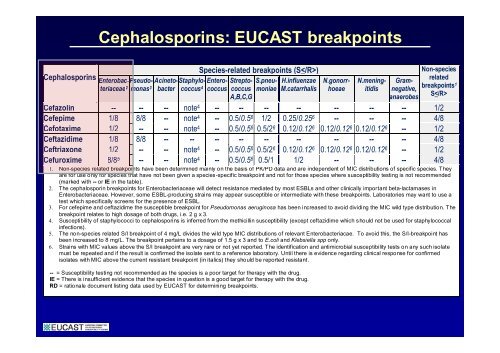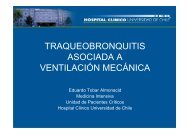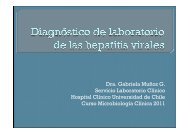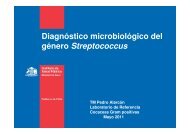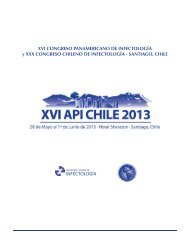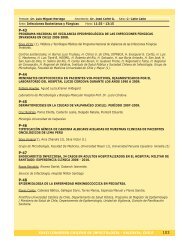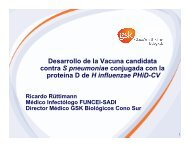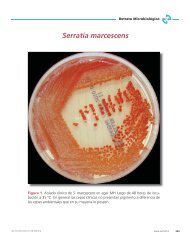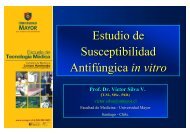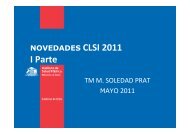Optimizando la comunicación entre el microbiológo y el clÃnico
Optimizando la comunicación entre el microbiológo y el clÃnico
Optimizando la comunicación entre el microbiológo y el clÃnico
Create successful ePaper yourself
Turn your PDF publications into a flip-book with our unique Google optimized e-Paper software.
Cephalosporins: EUCAST breakpoints<br />
Cephalosporins Enterobac-<br />
Cefazolin --<br />
Cefepime 1/8<br />
Cefotaxime 1/2<br />
Ceftazidime 1/8<br />
Ceftriaxone 1/2<br />
Cefuroxime 8/8 5<br />
Pseudoteriaceae<br />
2 monas 3<br />
Acinetobacter<br />
Staphylococcus<br />
4<br />
Species-re<strong>la</strong>ted breakpoints (S)<br />
Enterococcus<br />
Streptococcus<br />
A,B,C,G<br />
H.influenzae<br />
M.catarrhalis<br />
S.pneumoniae<br />
N.gonorrhoeae<br />
N.meningitidis<br />
Gramnegative,<br />
anaerobes<br />
Non-species<br />
re<strong>la</strong>ted<br />
breakpoints 1<br />
S<br />
-- -- note 4 -- -- -- -- -- -- -- 1/2<br />
8/8 -- note 4 -- 0.5/0.5 6 1/2 0.25/0.25 6 -- -- -- 4/8<br />
-- -- note 4 -- 0.5/0.5 6 0.5/2 6 0.12/0.12 6 0.12/0.12 6 0.12/0.12 6 -- 1/2<br />
8/8 -- -- -- -- -- -- -- -- -- 4/8<br />
-- -- note 4 -- 0.5/0.5 6 0.5/2 6 0.12/0.12 6 0.12/0.12 6 0.12/0.12 6 -- 1/2<br />
-- -- note 4 -- 0.5/0.5 6 0.5/1 1/2 -- -- -- 4/8<br />
1. Non-species re<strong>la</strong>ted breakpoints have been determined mainly on the basis of PK/PD data and are independent of MIC distributions of specific species. They<br />
are for use only for species that have not been given a species-specific breakpoint and not for those species where susceptibility testing is not recommended<br />
(marked with -- or IE in the table).<br />
2. The cephalosporin breakpoints for Enterobacteriaceae will detect resistance mediated by most ESBLs and other clinically important beta-<strong>la</strong>ctamases in<br />
Enterobacteriaceae. However, some ESBL-producing strains may appear susceptible or intermediate with these breakpoints. Laboratories may want to use a<br />
test which specifically screens for the presence of ESBL.<br />
3. For cefepime and ceftazidime the susceptible breakpoint for Pseudomonas aeruginosa has been increased to avoid dividing the MIC wild type distribution. The<br />
breakpoint re<strong>la</strong>tes to high dosage of both drugs, i.e. 2 g x 3.<br />
4. Susceptibility of staphylococci to cephalosporins is inferred from the methicillin susceptibility (except ceftazidime which should not be used for staphylococcal<br />
infections).<br />
5. The non-species re<strong>la</strong>ted S/I breakpoint of 4 mg/L divides the wild type MIC distributions of r<strong>el</strong>evant Enterobacteriacae. To avoid this, the S/I-breakpoint has<br />
been increased to 8 mg/L. The breakpoint pertains to a dosage of 1.5 g x 3 and to E.coli and Klebsi<strong>el</strong><strong>la</strong> spp only.<br />
6. Strains with MIC values above the S/I breakpoint are very rare or not yet reported. The identification and antimicrobial susceptibility tests on any such iso<strong>la</strong>te<br />
must be repeated and if the result is confirmed the iso<strong>la</strong>te sent to a reference <strong>la</strong>boratory. Until there is evidence regarding clinical response for confirmed<br />
iso<strong>la</strong>tes with MIC above the current resistant breakpoint (in italics) they should be reported resistant.<br />
-- = Susceptibility testing not recommended as the species is a poor target for therapy with the drug.<br />
IE = There is insufficient evidence that the species in question is a good target for therapy with the drug.<br />
RD = rationale document listing data used by EUCAST for determining breakpoints.


